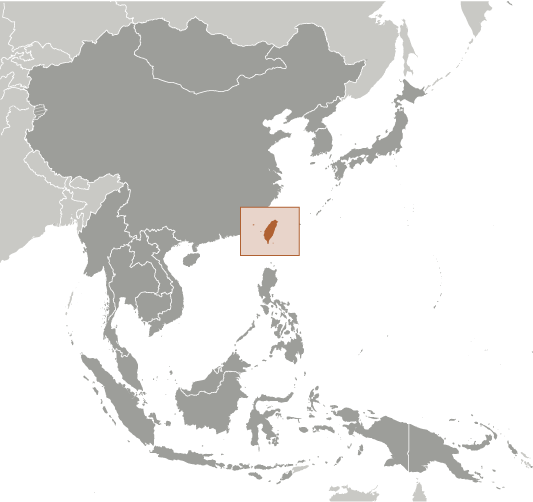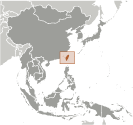
|
|
Advertisements:
EconomyEconomy - overview
Taiwan has a dynamic capitalist economy with gradually decreasing government guidance of investment and foreign trade. In keeping with this trend, some large, state-owned banks and industrial firms have been privatized. Exports, led by electronics, machinery, and petrochemicals have provided the primary impetus for economic development. This heavy dependence on exports exposes the economy to fluctuations in world demand. In 2009, Taiwan's GDP contracted 1.9%, due primarily to a 20% year-on-year decline in exports. In 2010 GDP grew 10.9%, as exports returned to the level of previous years, and in 2011, grew 5.2%. However, 2012 growth will likely be less, according to most forecasters, because of softening global demand. Taiwan's diplomatic isolation, low birth rate, and rapidly aging population are major long-term challenges. Free trade agreements have proliferated in East Asia over the past several years, but so far Taiwan has been excluded from this greater economic integration largely because of its diplomatic status with the exception of the landmark Economic Cooperation Framework Agreement (ECFA) signed with China in June 2010. The MA administration has said that the ECFA will serve as a stepping stone toward trade pacts with other regional partners, and negotiations on a deal with Singapore began this year. Follow-on components of ECFA, including deals on trade in goods, services, and investment, have yet to be completed. Taiwan's Total Fertility rate of just over one child per woman is among the lowest in the world, raising the prospect of future labor shortages, falling domestic demand, and declining tax revenues. Taiwan's population is aging quickly, with the number of people over 65 accounting for 10.9% of the island's total population as of 2011. The island runs a large trade surplus, and its foreign reserves are the world's fourth largest, behind China, Japan, and Russia. Since 2005 China has overtaken the US to become Taiwan's second-largest source of imports after Japan. China is also the island's number one destination for foreign direct investment. Three financial memorandums of understanding, covering banking, securities, and insurance, took effect in mid-January 2010, opening the island to greater investments from the mainland's financial firms and institutional investors, and providing new opportunities for Taiwan financial firms to operate in China. Closer economic links with the mainland bring greater opportunities for the Taiwan economy, but also poses new challenges as the island becomes more economically dependent on China while political differences remain unresolved. Gdp (purchasing power parity) World Ranking: 20
$887.3 billion (2011 est.)
$852.8 billion (2010 est.) $770.3 billion (2009 est.) Note Data are in 2011 US dollars Gdp (official exchange rate)
$466.8 billion (2011 est.)
Gdp - real growth rate World Ranking: 98
4% (2011 est.)
10.7% (2010 est.) -1.8% (2009 est.) Gdp - per capita (ppp) World Ranking: 27
$38,200 (2011 est.)
$36,800 (2010 est.) $33,300 (2009 est.) Note Data are in 2011 US dollars Gdp - composition by sector
Agriculture 1.3%
Industry 32% Services 66.9% (2011 est.) Labor force World Ranking: 48
11.2 million (2011 est.)
Labor force - by occupation
Agriculture 5.2%
Industry 35.9% Services 58.8% (2010 est.) Unemployment rate World Ranking: 44
4.4% (2011 est.)
5.2% (2010 est.) Population below poverty line
1.16% (2010 est.)
Household income or consumption by percentage share
Lowest 10% 6.4%
Highest 10% 40.3% (2010) Distribution of family income - gini index World Ranking: 101
32.6 (2000)
Investment (gross fixed) World Ranking: 81
21% of GDP (2011 est.)
Budget
Revenues $75.31 billion
Expenditures $90.67 billion (2011 est.) Taxes and other revenues World Ranking: 188
16.1% of GDP (2011 est.)
Budget surplus (+) or deficit (-) World Ranking: 105
-3.3% of GDP (2011 est.)
Public debt World Ranking: 89
36.3% of GDP (2011 est.)
33.4% of GDP (2010 est.) Inflation rate (consumer prices) World Ranking: 15
1.4% (2011 est.)
1% (2010 est.) Central bank discount rate World Ranking: 131
1.625% (31 December 2010)
1.25% (February 2009) Commercial bank prime lending rate World Ranking: 177
2.8% (31 December 2011 est.)
2.676% (31 December 2010 est.) Stock of narrow money World Ranking: 15
$366.4 billion (31 December 2011 est.) $377.3 billion (31 December 2010 est.) Stock of broad money World Ranking: 16
$1.134 trillion (31 December 2011 est.) $1.022 trillion (31 December 2010 est.) Stock of domestic credit World Ranking: 18
$792.2 billion (31 December 2011 est.) $751.5 billion (31 December 2010 est.) Market value of publicly traded shares World Ranking: 19
$784.1 billion (31 December 2010) $657.3 billion (31 December 2009) $354.7 billion (31 December 2008) Agriculture - products
Rice, vegetables, fruit, tea, flowers; pigs, poultry; fish Industries
Electronics, communications and information technology products, petroleum refining, armaments, chemicals, textiles, iron and steel, machinery, cement, food processing, vehicles, consumer products, pharmaceuticals
Industrial production growth rate World Ranking: 63
5% (2011 est.)
Electricity - production World Ranking: 17
229.1 billion kWh (2009)
Electricity - consumption World Ranking: 16
220.8 billion kWh (2009)
Electricity - exports
0 kWh (2009 est.)
Electricity - imports
0 kWh (2009 est.)
Oil - production World Ranking: 74
26,680 bbl/day (2010 est.)
Oil - consumption World Ranking: 21
1.002 million bbl/day (2010 est.) Oil - exports World Ranking: 42
303,000 bbl/day (2010 est.)
Oil - imports World Ranking: 16
876,300 bbl/day (2010 est.)
Oil - proved reserves World Ranking: 94
2.38 million bbl (1 January 2011 est.) Natural gas - production World Ranking: 74
310 million cu m (2009 est.)
Natural gas - consumption World Ranking: 44
12.1 billion cu m (2009 est.)
Natural gas - exports World Ranking: 190
0 cu m (2009 est.)
Natural gas - imports World Ranking: 23
11.79 billion cu m (2009 est.)
Natural gas - proved reserves World Ranking: 86
6.229 billion cu m (1 January 2011 est.) Current account balance World Ranking: 13
$41.27 billion (2011 est.)
$39.87 billion (2010 est.) Exports World Ranking: 19
$307.1 billion (2011 est.)
$273.8 billion (2010 est.) Exports - commodities
Electronics, flat panels, machinery; metals; textiles, plastics, chemicals; optical, photographic, measuring, and medical instruments Exports - partners
China 28.1%, Hong Kong 13.8%, US 11.5%, Japan 6.6%, Singapore 4.4% (2010 est.) Imports World Ranking: 20
$279.4 billion (2011 est.)
$247.3 billion (2010 est.) Imports - commodities
Electronics, machinery, crude petroleum, precision instruments, organic chemicals, metals Imports - partners
Japan 20.7%, China 14.2%, US 10%, South Korea 6.4%, Saudi Arabia 4.7% (2010 est.) Reserves of foreign exchange and gold World Ranking: 6
$390.6 billion (31 December 2011 est.) $387.2 billion (31 December 2010 est.) Debt - external World Ranking: 37
$125.8 billion (31 December 2011 est.) $101.7 billion (31 December 2010 est.) Stock of direct foreign investment - at home World Ranking: 51
$61.39 billion (31 December 2011 est.) $63.38 billion (31 December 2010 est.) Stock of direct foreign investment - abroad World Ranking: 24
$137.3 billion (31 December 2011 est.) $124.5 billion (31 December 2010 est.) Exchange rates
New Taiwan dollars (TWD) per US dollar - 29.05 (2011 est.)31.648 (2010 est.) 33.061 (2009) 31.53 (2008) 32.84 (2007) Fiscal year
Calendar year
Comments
Add a new comment: |
Advertisement
Members area
Taiwan (Taipei):
 
GPS points from Taiwan (Taipei)
|
||||||||

 In 1895, military defeat forced China to cede Taiwan to Japan. Taiwan reverted to Chinese control after World War II. Following the Communist victory on the mainland in 1949, 2 million Nationalists fled to Taiwan and established a government using the 1947 constitution drawn up for all of China. Over the next five decades, the ruling authorities gradually democratized and incorporated the local population within the governing structure. In 2000, Taiwan underwent its first peaceful transfer of power from the Nationalist to the Democratic Progressive Party. Throughout this period, the island prospered and became one of East Asia's economic "Tigers." The dominant political issues continue to be the relationship between Taiwan and China - specifically the question of Taiwan's eventual status - as well as domestic political and economic reform.
In 1895, military defeat forced China to cede Taiwan to Japan. Taiwan reverted to Chinese control after World War II. Following the Communist victory on the mainland in 1949, 2 million Nationalists fled to Taiwan and established a government using the 1947 constitution drawn up for all of China. Over the next five decades, the ruling authorities gradually democratized and incorporated the local population within the governing structure. In 2000, Taiwan underwent its first peaceful transfer of power from the Nationalist to the Democratic Progressive Party. Throughout this period, the island prospered and became one of East Asia's economic "Tigers." The dominant political issues continue to be the relationship between Taiwan and China - specifically the question of Taiwan's eventual status - as well as domestic political and economic reform.